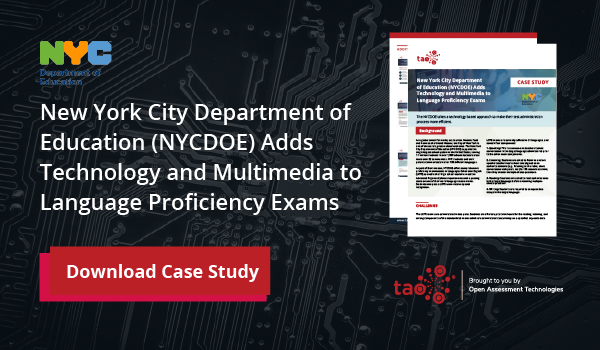Multilingual skills are increasingly critical for student success in today’s interconnected world. For that reason, educators need to measure language proficiency as effectively as possible.
While paper-based tests were traditionally the norm for this kind of mass testing, online assessments now offer greater efficiency and cost-effectiveness. However, these digital tools may require a significant investment for access to a platform—as well as teacher training and internal technical support. Therefore, choosing the best online assessment for language proficiency is essential.
This article delves into 5 top benefits of online language proficiency testing, making it easier to weigh the options. By the end, you’ll be equipped to choose an online assessment tool that maximizes these benefits for both educators and language learners.
Key Takeaways
- Online assessment tools improve the efficacy and efficiency of mass language proficiency testing.
- The benefits include cost savings, scoring precision, efficient data reporting, multimedia elements, and accessibility features.
- The best online assessments for language proficiency leverage all of these benefits.
5 Benefits of Online Assessment for Mass Language Proficiency
Online assessment tools offer numerous benefits for the main types of mass language proficiency testing, including, for example:
- English proficiency exams for English learners (ELs), which determine students’ eligibility for services and fulfill federal funding requirements in the United States
- World language exams, which determine students’ eligibility for graduation, academic honors, postsecondary opportunities, or a Seal of Biliteracy.
Both types assess achievement in 4 areas of the target language: listening, reading, speaking, and writing—and online assessment tools can streamline the delivery of each of these assessment domains.
To help you make an informed decision about the best online assessment, we cover 5 of the most significant benefits below.
Cost-effectiveness
The digital approach to language testing offers many cost-saving benefits.
First, online assessments eliminate printing and distribution expenses associated with non-digital formats. Paper-based versions of reading passages and vocabulary questions require school systems to print test booklets and answer sheets, which is expensive.
For example, the New York City Department of Education (NYCDOE) reduced paper-based costs by using TAO’s online assessment tools for their Spanish Language Proficiency Exams, which are given to 20,000 students per year.
Online language proficiency assessments also reduce the staffing expenses of oral proficiency interviews (OPIs). Previously, these entailed hiring multi-lingual interviewers to direct 1-on-1 conversations with each student in the target language. The costs included hourly wages ($28 USD per hour on average), training, and facilities. With online assessments, however, students converse with a computer avatar and record their answers on the platform.
Online assessments reduce scoring costs, too. The platforms automatically score selected-response questions on the listening and reading portions of language proficiency exams. What’s more, platforms with automated essay scoring (AES) use machine learning algorithms to instantly assess the grammar and vocabulary of essay responses in the target language.
Even without AES, digital assessment platforms can make the job of essay scoring faster, and thus less expensive. For example, with TAO Grader, human raters can add scores for each rubric requirement without having to spend time switching between paper essays and scoring tools.
Open-response scoring precision
Online assessments also deliver better scoring precision for students’ open responses for the speaking and writing portions of language proficiency tests. These responses enable online human-scoring according to rubric-based criteria, such as vocabulary and grammar. When these tools are conveniently built into the same platform as the student responses, it reduces the human error associated with uploading recordings or essays, rubrics, etc across different platforms.
Online assessment tools also streamline processes for evaluating inter-rater reliability. With a digital platform, assigning more than 1 rater to each response is more feasible. Test administrators can more easily check the consistency of scores across raters and efficiently address scoring inaccuracies or inconsistencies.
The automatic scoring tools available on some online assessment platforms can also reduce rater bias. After the tests are complete, the tool evaluates open responses and generates initial baseline scores before human raters evaluate the writing to provide the final score. With access to these machine-based scores, human scorers can reduce variability across the cohort and calibrate their scoring to align more closely to the objective standard.
Faster scoring and reporting
With online assessment tools, school systems can also receive scores and student performance data in less time than with paper-based assessments.
For selected-response questions on the listening and reading portions of language proficiency tests, online platforms provide immediate scoring. For the open responses of speaking and writing components that might require human scoring, results also become available more quickly. For example, TAO instantly calculates the total score for each student’s test as soon as human raters manually score open-response items.
School systems can also quickly capture data about individual and school-wide language proficiency trends from online assessments. Online platforms have built-in data analysis tools that generate reports on students’ performance with each target language skill. With these reports, educators can immediately identify skills gaps to address with personalized interventions.
Schools can also use this performance data to identify improvement areas for the language curriculum. For example, if reports indicate that a significant number of English learners are missing verb conjugation skills, the school can modify the ESOL curriculum to address those gaps.
Multimedia features
Online language proficiency tests can leverage a variety of multimedia features to engage language learners. Some of these include the following:
- The audio clips for listening comprehension tasks on digital assessments have high-quality sound. The digital format also allows test designers to use more authentic content—such as news reports or television dialogue—versus contrived or scripted conversations.
- Images and infographics on language test items enhance performance and provide context for the questions and instructions. These can take the form of video components for audio clips or pictures on reading passages and essay prompts. A 2017 study found that representational pictures on test items reduced item difficulty and improved student effort.
- Technology-enhanced interactions (TEIs) incorporate interactive tasks like drag-and-drop or clicking on portions of an image. Studies have shown that interactive test questions improve student engagement.
Accommodations for diverse needs
Online language proficiency tests also offer benefits for language learners with diverse needs and disabilities, as the digital format provides accessibility features that aren’t available with paper-based tests. For example, online assessments can accommodate students who are blind, have low vision, or have reading difficulties through the use of the following tools:
- Screen readers provide an audio version of written instructions, reading passages, multiple-choice questions, and other text.
- Alternative text descriptions provide screen readers with descriptions of images so that they can communicate the content in an audio format. For example, if a student cannot access an image visually, the screen reader will describe it in their primary language.
- Magnification tools and adjustable font sizes enlarge graphics and text so they’re accessible to language learners with low vision or reading difficulties, such as dyslexia.
- Audio replay features allow students to re-listen to audio instructions and listening-comprehension questions as many times as needed to fully comprehend the audio content.
- Audio control features allow students to adjust the volume of listening comprehension questions to their needs.
In addition to better serving students with disabilities, online assessments are more accessible for English learners who are studying languages other than English. Online assessment platforms such as TAO can translate the English content of a world language assessment into almost any other language. As a result, students can receive questions and instructions in their primary languages so that the test results are not impacted by language barriers.
—
Online assessments are powerful tools for measuring language proficiency. By embracing them, educators can reduce costs, improve scoring precision, and generate faster scores and data. They can also engage more language learners with multimedia features and better accommodate diverse needs.
With these promising assessment technologies, educators can expand students’ opportunities and improve language proficiency. For more information about language proficiency assessment, please see How to Build Streamlined Language Assessments, 6 Strategies for Assessing English Language Learners, and other articles in the TAO blog.
FAQs
What are the cost savings of online assessments for mass language proficiency testing?
Online assessments eliminate the costs of exam booklets, answer sheets, and 1-on-1 speaking assessments.
What features make online assessments engaging for language learners?
Multimedia features such as audio clips, images, videos, and interactive questions keep test-takers engaged in language proficiency tests. They also improve outcomes.


